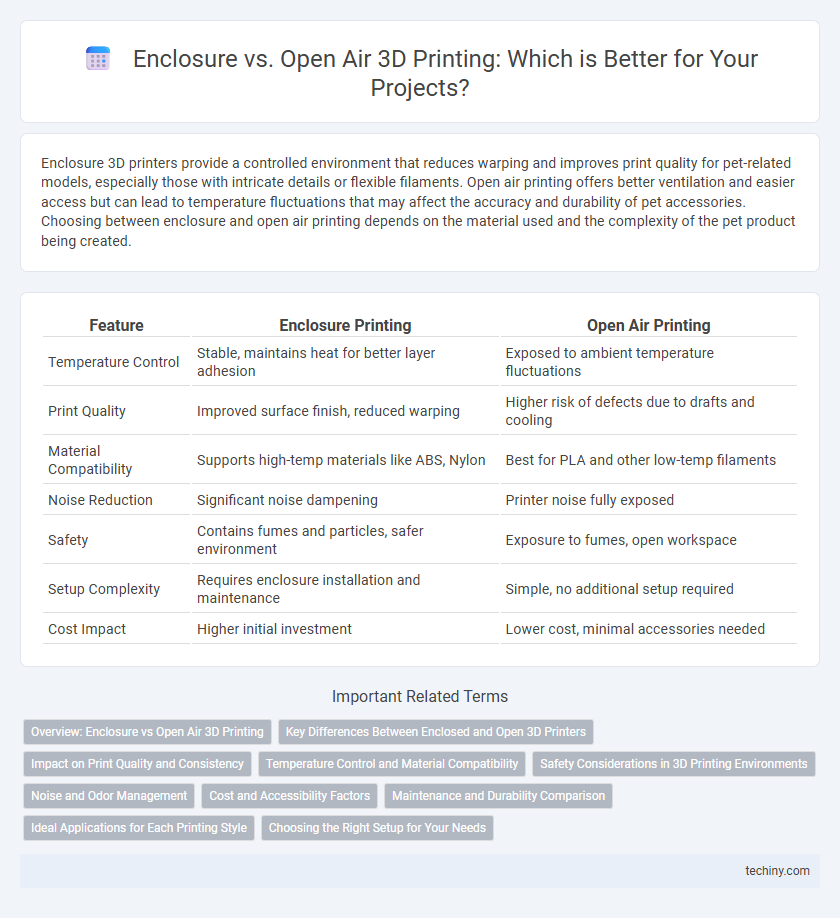Enclosure 3D printers provide a controlled environment that reduces warping and improves print quality for pet-related models, especially those with intricate details or flexible filaments. Open air printing offers better ventilation and easier access but can lead to temperature fluctuations that may affect the accuracy and durability of pet accessories. Choosing between enclosure and open air printing depends on the material used and the complexity of the pet product being created.
Table of Comparison
| Feature | Enclosure Printing | Open Air Printing |
|---|---|---|
| Temperature Control | Stable, maintains heat for better layer adhesion | Exposed to ambient temperature fluctuations |
| Print Quality | Improved surface finish, reduced warping | Higher risk of defects due to drafts and cooling |
| Material Compatibility | Supports high-temp materials like ABS, Nylon | Best for PLA and other low-temp filaments |
| Noise Reduction | Significant noise dampening | Printer noise fully exposed |
| Safety | Contains fumes and particles, safer environment | Exposure to fumes, open workspace |
| Setup Complexity | Requires enclosure installation and maintenance | Simple, no additional setup required |
| Cost Impact | Higher initial investment | Lower cost, minimal accessories needed |
Overview: Enclosure vs Open Air 3D Printing
Enclosure 3D printing provides a controlled environment that stabilizes temperature and reduces warping, improving print quality for materials like ABS and nylon. Open air printing allows for easy access and better ventilation but is more susceptible to temperature fluctuations, which can affect print adhesion and consistency. Choosing between enclosure and open air setups depends on the material, print complexity, and desired surface finish.
Key Differences Between Enclosed and Open 3D Printers
Enclosed 3D printers provide a controlled environment that stabilizes temperature and reduces warping for materials like ABS, while open-air printers offer easier access and better ventilation, ideal for PLA and less temperature-sensitive filaments. Enclosures minimize dust and debris interference, improving print quality and safety by containing fumes, whereas open printers deliver faster heat dissipation and cooling. Noise reduction is another advantage of enclosed printers, important for office or home settings, compared to the louder operation of open-frame models.
Impact on Print Quality and Consistency
Enclosed 3D printers maintain a stable temperature and protect prints from drafts, reducing warping and layer separation for improved print quality and consistency. Open air printing exposes models to environmental fluctuations, which can cause uneven cooling and increased risk of defects like cracking or delamination. Using an enclosure is especially beneficial for printing temperature-sensitive materials such as ABS and Nylon that require controlled conditions to achieve optimal layer adhesion and surface finish.
Temperature Control and Material Compatibility
Enclosure 3D printers provide precise temperature control by maintaining a stable environment, reducing warping and improving print quality for materials like ABS, Nylon, and Polycarbonate that require consistent heat. Open air printing allows for easier access but often results in temperature fluctuations that can cause layer adhesion issues and print defects, limiting material compatibility primarily to PLA and PETG. Controlling ambient temperature within an enclosure enhances print reliability and supports a wider range of high-performance filaments.
Safety Considerations in 3D Printing Environments
Enclosed 3D printers significantly enhance safety by containing fumes, particles, and high temperatures within a controlled environment, reducing exposure to harmful emissions and minimizing burn risks. Open air printing exposes operators to volatile organic compounds (VOCs) and ultrafine particles (UFPs) released from filament melting, necessitating effective ventilation and personal protective equipment. Proper enclosure design integrates filtration systems and thermal insulation, ensuring compliance with workplace safety standards and promoting a safer additive manufacturing workspace.
Noise and Odor Management
Enclosure systems in 3D printing significantly reduce noise levels by containing the printer's mechanical sounds within a confined space, which benefits home and office environments. They also improve odor management by limiting the release of potentially harmful fumes from filament materials like ABS or PETG, using built-in filters or ventilation. Open air printing allows for better heat dissipation but increases exposure to noise and emitted odors, making enclosures the preferred choice for controlled, quieter, and safer printing conditions.
Cost and Accessibility Factors
Enclosure printing systems typically incur higher costs due to specialized components like heated chambers and ventilation, while open air printers are more affordable and accessible for beginners and hobbyists. Enclosures enhance print quality by stabilizing temperature and reducing warping but may require additional maintenance and setup complexity. Open air printers offer greater ease of use and lower initial investment, making them suitable for educational purposes and rapid prototyping despite potential compromises in print consistency.
Maintenance and Durability Comparison
Enclosure 3D printers offer improved maintenance by providing a controlled environment that reduces dust, debris, and temperature fluctuations, leading to less frequent cleaning and part replacements. Open air printing requires more regular maintenance due to exposure to contaminants and cooling inconsistencies, which can cause nozzle clogging and print warping. Enclosed printers enhance durability of both the machine components and printed parts by stabilizing ambient conditions, thereby prolonging overall operational lifespan.
Ideal Applications for Each Printing Style
Enclosed 3D printers excel in temperature-sensitive applications such as ABS and Nylon printing, providing stable heat retention to minimize warping and improve layer adhesion. Open air printing is ideal for materials like PLA and PETG that do not require controlled environments, allowing better ventilation and ease of access for quick prototyping and educational purposes. Professionals leverage enclosures for high-precision industrial parts, while hobbyists and beginners often prefer open air setups for simple, low-warp models.
Choosing the Right Setup for Your Needs
Enclosure 3D printers maintain consistent temperatures, reducing warping and improving print quality for materials like ABS and Nylon, while open air printing suits PLA and other less temperature-sensitive filaments. Selecting the right setup depends on your material choice, environmental conditions, and desired print precision. Enclosures also enhance safety by containing fumes and minimizing dust, making them ideal for professional or high-detail projects.
Enclosure vs Open Air Printing Infographic

 techiny.com
techiny.com